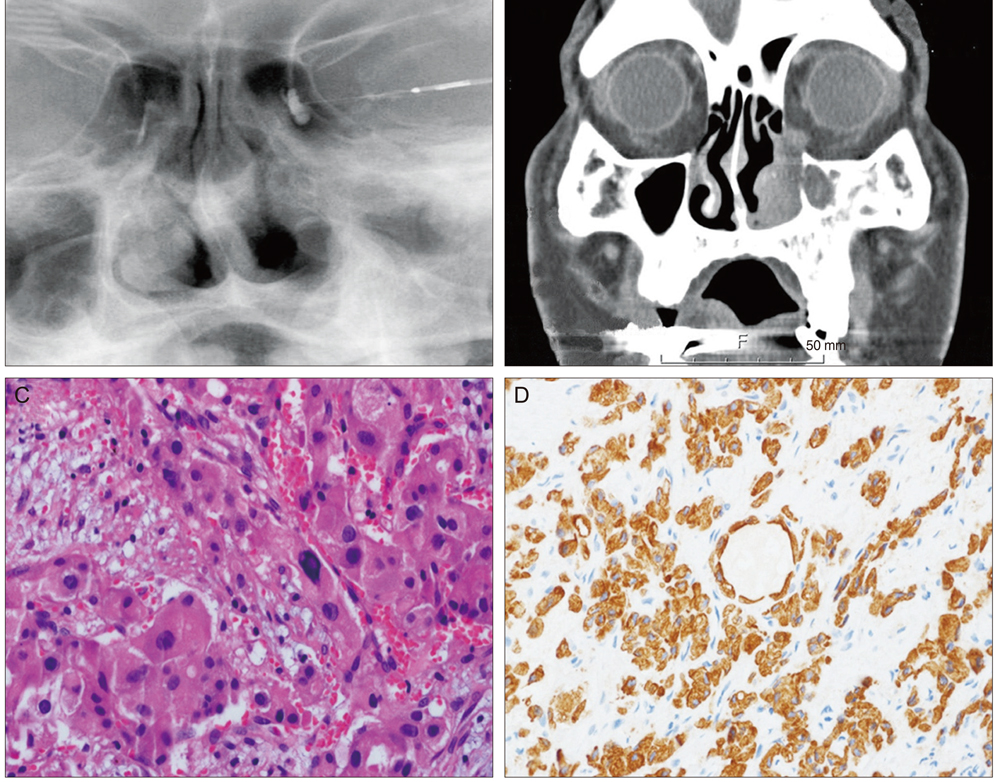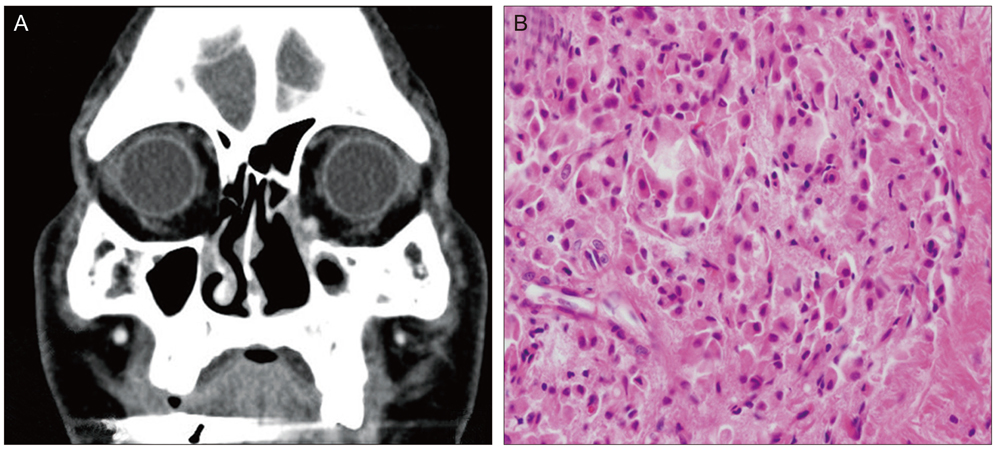Korean J Ophthalmol.
2013 Apr;27(2):126-129. 10.3341/kjo.2013.27.2.126.
Nasolacrimal Duct Obstruction Caused by Oncocytic Carcinoma
- Affiliations
-
- 1Department of Ophthalmology, Pusan National University Yangsan Hospital, Yangsan, Korea.
- 2Research Institute for Convergence of Biomedical Science and Technology, Pusan National University Yangsan Hospital, Yangsan, Korea.
- 3Department of Pathology, Pusan National University Yangsan Hospital, Yangsan, Korea.
- 4Department of Otolaryngology, Pusan National University Hospital, Busan, Korea.
- 5Department of Ophthalmology, Pusan National University Hospital, Busan, Korea. hychoi@pusan.ac.kr
- 6Medical Research Institute, Pusan National University, Busan, Korea.
- KMID: 1503805
- DOI: http://doi.org/10.3341/kjo.2013.27.2.126
Abstract
- Here, we report an extremely rare case of acquired nasolacrimal duct obstruction caused by oncocytic carcinoma. A 64-year-old man presented to the hospital complaining of epiphora and left-side nasal obstruction. Ophthalmic and otolaryngology examination revealed a left lacrimal duct obstruction caused by a mass in the left nasal cavity and lacrimal drainage system. The mass was removed and confirmed as an oncocytic carcinoma. Nine months after surgery, without adjuvant radiotherapy, a left orbital mass was observed and the patient underwent reoperation. The mass proved to be recurrent oncocytic carcinoma. The patient underwent adjuvant radiotherapy to eradicate any residual tumor and the patient remains tumor-free one year post-radiotherapy.
Keyword
MeSH Terms
Figure
Reference
-
1. Wakely PE Jr. Oncocytic and oncocyte-like lesions of the head and neck. Ann Diagn Pathol. 2008. 12:222–230.2. Anderson NG, Wojno TH, Grossniklaus HE. Clinicopathologic findings from lacrimal sac biopsy specimens obtained during dacryocystorhinostomy. Ophthal Plast Reconstr Surg. 2003. 19:173–176.3. Gnepp DR, Henley JD, Roderick HW. Gnepp DR, editor. Salivary and lacrimal glands: oncocytic lesions and tumors. Diagnostic surgical pathology of the head and neck. 2009. Philadelphia: Saunders Elsevier;413–561.4. Gray SR, Cornog JL Jr, Seo IS. Oncocytic neoplasms of salivary glands: a report of fifteen cases including two malignant oncocytomas. Cancer. 1976. 38:1306–1317.5. Nakada M, Nishizaki K, Akagi H, et al. Oncocytic carcinoma of the submandibular gland: a case report and literature review. J Oral Pathol Med. 1998. 27:225–228.6. Corbridge RJ, Gallimore AP, Dalton CG, O'Flynn PE. Oncocytomas of the upper jaw. Head Neck. 1996. 18:374–380.7. Hamperl H. Benign and malignant oncocytoma. Cancer. 1962. 15:1019–1027.8. Hamperl H. Onkocytoma of the salivary glands. Z Krebsforsch. 1962. 64:427–440.9. Cohen MA, Batsakis JG. Oncocytic tumors (oncocytomas) of minor salivary glands. Arch Otolaryngol. 1968. 88:71–73.10. Mahmoud NA. Malignant oncocytoma of the nasal cavity. J Laryngol Otol. 1979. 93:729–734.11. DiMaio SJ, DiMaio VJ, DiMaio TM, et al. Oncocytic carcinoma of the nasal cavity. South Med J. 1980. 73:803–806.12. Savic D, Djeric D, Jasovic A. Oncocytoma of the nose and ethmoidal and sphenoidal sinuses. Rev Laryngol Otol Rhinol (Bord). 1989. 110:481–483.13. Fayet B, Bernard JA, Zachar D, et al. Malignant nasal oncocytoma disclosed by mucocele of the lacrimal sac with hemolacrimia. J Fr Ophtalmol. 1990. 13:153–158.14. Martin H, Janda J, Behrbohm H. Locally invasive oncocytoma of the nasal cavity. Zentralbl Allg Pathol. 1990. 136:703–706.15. Harrison DF, Lund VJ. Tumours of the upper jaw. 1993. Edinburgh: Churchill Livingstone;108.16. Forster C, Ostertag H. Oncocytoma of the nose: a case report and review of the literature. Pathologe. 1995. 16:431–433.17. Nayak DR, Pillai S, Balakrishnan R, et al. Malignant oncocytoma of the nasal cavity: a case report. Am J Otolaryngol. 1999. 20:323–327.18. Abe T, Murakami A, Nakajima N, et al. Oncocytic carcinoma of the nasal cavity with widespread lymph node metastases. Auris Nasus Larynx. 2007. 34:393–396.19. Hu YW, Lin CZ, Li WY, et al. Locally advanced oncocytic carcinoma of the nasal cavity treated with surgery and intensity-modulated radiotherapy. J Chin Med Assoc. 2010. 73:166–172.
- Full Text Links
- Actions
-
Cited
- CITED
-
- Close
- Share
- Similar articles
-
- A Case of Nasolacrimal Duct Obstruction after Two-Jaw Surgery
- Nasolacrimal Duct Obstruction Following Midfacial Autologous Fat Injection
- A Case of Nasolacrimal Duct Obstruction Caused by a Lacrimal Sac Retention Cyst
- A Case of Angioleiomyoma in Nasolacrimal Duct
- The Methods of Insertiong the Root-type Lacrimal Tube and an Artificial nasolacrimal duct into the Men's



